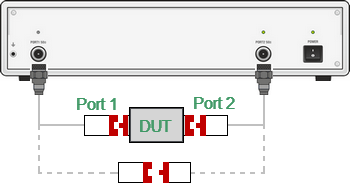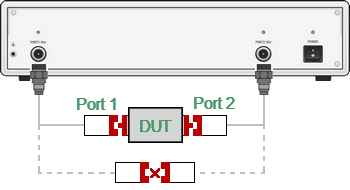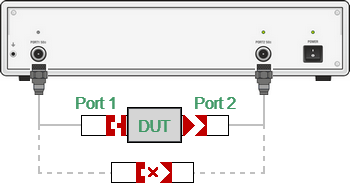The two-port SOLT calibration procedure includes direct connection of test port cables with each other. Such connection is called Zero length THRU or Flush THRU and means that THRU has zero electrical length. However, it is not always possible to connect test port cables directly to each other. According to this criterion, DUTs are divided into insertable and non-insertable devices:
•An insertable device is one whose connectors could match together. They have the same type of connector and opposite or no gender. Test port cables can be matched together (See figures below), therefore a two-port SOLT calibration can be performed for such a measurement setup.

Insertable Device
•A non-insertable device is one whose connectors could not match together. This also means that the test port cables would not match each other. In the simplest case, a non-insertable device has connectors of the same type, for example, N50, and of the same gender (See figures below).

Non-insertable Device (connectors of the same type)
In practice, there are often more complex cases of non-insertable device measurements — devices having ports of different types and/or having different characteristic impedances, for example, N50 – 3.5, N50 – N75, N50 – Waveguide (See figures below).

Non-insertable Device (connectors of different types)
The following calibration methods are used for a non-insertable device:
•DEFINED THRU
•UNKNOWN THRU calibration
•UNKNOWN THRU Addition function
•Adapter Removal/Insertion
Defined Thru
This method uses physical (not null) DEFINED THRU in two-port SOLT calibration (See Full Two-Port Calibration). Parameters of the DEFINED THRU must be defined in the calibration kit. If the definition of DEFINED THRU is not included in the calibration kit, it must be added manually using one of two methods: parameters of calibration standard model or S-parameters. For a detailed description, see Calibration Standard Definition.
Unknown Thru calibration
This method uses physical (not null) UNKNOWN THRU in two-port calibration. Such calibration is called SOLR (Short-Open-Load-Reciprocal).
Any two-port network satisfying the reciprocal condition (S12 = S21) can be used as UNKNOWN THRU. Most passive, linear microwave networks will turn out to be reciprocal. Combined transmission loss of UNKNOWN THRU and calibration setup should not exceed 40 dB. The UNKNOWN THRU can be a wide class of two-port network, including DUT, if it meets the specified conditions.
The only parameter of UNKNOWN THRU, which should be known in advance is approximate electrical delay. In most cases, there is no need to enter its value manually, since the Analyzer has the function of automatic detection of the UNKNOWN THRU electrical delay. For a detailed description, see Unknown Thru Requirements.
This method is applicable when both test ports can be calibrated using the same calibration kit. For example, test ports of the same type, and of the same gender. For a detailed description, see Unknown Thru Calibration. For this purpose, the software includes an UNKNOWN THRU standard in the description of each predefined calibration kit.
Unknown Thru Addition function
The main difference between this method and Unknown Thru calibration is that the calibration is carried out in two steps. A one-port calibration of each port must be performed in advance using a mechanical calibration kit (See Full One-Port Calibration) or ACM. Then the Unknown Thru Addition function measures UNKNOWN THRU and completes the two-port calibration. Since it is possible to select an individual calibration kit for each one-port calibration, the test ports can be of different types, up to a combination of coaxial and waveguide types. For a detailed description, see Unknown Thru Addition.
Adapter Removal/Insertion function
Adapter Removal function used to remove any adapter characteristics from the calibration plane.
Adapter Insertion function used to insert any adapter characteristics to the calibration plane.
The initial calibration plane is established by two-port SOLT calibration with Zero-length THRU. Then both functions use an additional measurement of the three standards (Short-Open-Load) to mathematically remove or insert the adapter.
Requirements for the adapter in the Adapter Removal/Insertion function are the same as for UNKNOWN THRU. For a typical adapter transition between different types of connectors, these requirements are easily met. For a detailed description, see Adapter Removal/Insertion.
Accuracy of Methods
•Unknown Thru calibration (SOLR) is potentially most accurate method and is preferable method for non-insertable device measurement.
•Unknown Thru addition accuracy is comparable to SOLR.
•The Adapter Removal/Insertion method is less accurate than Unknown Thru methods as it requires more standard connections (10 connections compared to 7 connections in SOLR).
•Defined Thru is usually more accurate than Adapter Removal, but not as accurate as Unknown Thru method.